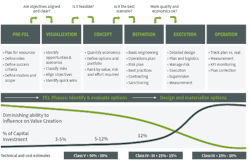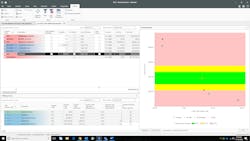Utility professionals are under increasing pressure to submit more accurate budgets for capital projects and required operations and maintenance work to improve network resilience and deliver services that meet the needs of their customers. This holds true not only for internal stage gate funding approvals, but also when interacting with external agencies and commissions, especially when negotiating utility rate schedules. Fortunately, there are several industry best practices that solve many of the cost estimating challenges water utilities are facing.
Typically, an estimate for a new capital project would be refined several times, each time with the appropriate class of estimate to accurately communicate the estimated cost, risk profile, risk mitigation strategy, schedule duration and planned outage metrics to various project stakeholders prior to the project being executed. In theory, these various classes of estimate should become more detailed with less contingency allowance as the project’s funding initiative passes through the various stages leading to an investment decision. In many organizations, estimate classes follow well-defined Front-End Loading (FEL) phases.
This process intertwines with the work being done on the design and engineering fronts, as there is rarely a comprehensive, final design package available at the beginning of the estimation process. This is to be expected as requirements often change during the design phase as new information is discovered. In fact, a project’s owner has the most opportunity to affect the project’s value creation during these early stages. It is not uncommon for requirements to shift and for new design and engineering data to become available as the candidate project passes through each approval gate. How then, can costs, risks and durations be accurately estimated when the scope of the project seems to be in constant flux? Industry best practices include leveraging historical information in the form of benchmarks, dynamic ties between systems, a detailed change management strategy and automating comprehensive materials takeoff schemes.
Benchmarks
Where do the best benchmarks come from? While there are a number of commercial construction cost databases available for purchase, these may or may not accurately reflect what a particular utility has paid to complete this type of work. Variables such as seasonality, market conditions affecting competition for skilled craft labor and specialty equipment are typically not factored into these databases. Studies have shown the best benchmark data emanates from within a particular organization’s own history.
Gathering this data has traditionally been met with challenges as data is collected at different levels of detail than has been used in the project’s plan. However, modern field data capture tools now exist to plan the work the way it will be performed, while all of the underlying productivity and cost assumptions used in the estimate are available to determine if work is being performed to budget. This information is then stored centrally, where it can be leveraged by all project team members for future projects.
The more cycles through which an organization measures actual cost performance and uses it as the basis of future estimates, the more aligned estimated and actual costs will become. As a result, each project’s true costs become more and more predictable.
Dynamic Integration
Historically, certain functional areas within a utility have been established with their own systems, and opportunities for seamlessly integrated project data were rare. However, project stakeholders can now take advantage of integrations between a design model of a project, a detailed cost model (including scope, quantities, and resources) and a schedule. This allows for project team members to strategize on any detail from the project’s phasing to individual crew sizes to determine the impact each scope change will have on the project’s cost, duration and resource requirements — even at early estimate stages.
Change is Constant
As mentioned previously, change is inevitable as a potential project is progressing through its various approval gates. Modern database systems are able to capture budgeted costs, scope and resource requirements at each stage of the approval process. Project teams can now isolate and identify the impact of new design decisions, in addition to changes in resource cost rates (e.g., due to escalation) as the proposed project’s scope and timeline are modified. Powerful budgeting tools support business processes whereby approved scope can be added to a project’s current budget, which can be offset by drawing down the appropriate amount of contingency. Actual contingency drawdown values, in both dollars and percentage of direct costs and workforce hours, are now available as actual values to facilitate future benchmarks.
Automated Takeoff
So much of the work planned and executed in a utility project is based on a large number of variables.
Comprehensive knowledge bases, formerly confined to internally developed spreadsheets and particular engineers’ brains, can now be centrally developed and deployed to allow all team members to identify and input these variables in a deliberate, interview-like manner. This ensures the proper methodologies are used to plan and estimate the work in a consistent manner. This includes details regarding the identification of long-lead materials requirements, specialty equipment, and optimum crew sizes, all the way down to the nuts, bolts and gaskets required to build the project in a predictable manner.
Conclusion
Utilities are faced with increased reporting requirements and are under continued pressure to engineer costly surprises out of their planned capital and maintenance work. By having a reliable, repeatable process for estimating, validating and measuring project costs, utilities can be better prepared for these changes; with a greater handle on the costs required to treat and distribute clean water to their customers. WW
About the Author: Rick Deans is executive vice president, industry engagement, for InEight. Deans spends his time with InEight’s largest and most strategic customers, oversees InEight’s Industry Advisory Group and is constantly exploring innovative ways to provide accelerated value to clients. He has a 20-year background serving the infrastructure, power, mining, oil & gas and public utility industries.
About the Author
Rick Deans
Rick Deans is Executive Vice President, industry engagement, for InEight. Deans spends his time with InEight’s largest and most strategic customers, oversees InEight’s Industry Advisory Group and is constantly exploring innovative ways to provide accelerated value to clients. He has a 20-year background serving the infrastructure, power, mining, oil & gas and public utility industries.


